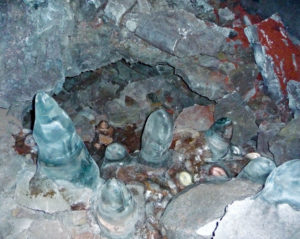 Diamonds may seem beautiful and precious all on their own, but a recently published article in Science revealed the extra value of one diamond in particular. Geoscientists have recently found a tiny piece of a type of ice never before discovered on Earth within a diamond formed under extreme pressure millions of years ago, as the Los Angeles Times reported.
Diamonds may seem beautiful and precious all on their own, but a recently published article in Science revealed the extra value of one diamond in particular. Geoscientists have recently found a tiny piece of a type of ice never before discovered on Earth within a diamond formed under extreme pressure millions of years ago, as the Los Angeles Times reported.
Here on the Earth’s surface, scientists have already identified multiple types of ice: The most common, most familiar, and least-dense type is known scientifically as type “ice-I.” Ice-I is the same density as the ice we typically encounter in cold weather and that we put in our drinks. As ice is placed under greater and greater amounts of pressure, however, its density increases and its oxygen atoms rearrange, forming into different types of ice. Each subsequent ice type is characterized by its greater density and the differing arrangement of its oxygen molecules.
Ice-II, ice-III, ice-IV, ice-V, and even ice-VI have all been discovered before on Earth. Ice-VII, however, has not, though it appears to be abundant elsewhere in our solar system and has previously been synthesized in a lab. The reason for its rarity is that the extreme pressures needed to created ice-VII only exist naturally in areas that are too warm to allow water to freeze, such as deep in the Earth’s crust and mantle.
That’s why the accidental discovery of ice-VII, locked inside a diamond that was itself formed deep below the Earth’s surface, is so exciting. The new study shows that diamonds can continue hold water inside them at the same incredible levels of pressure under which they were formed even as they push toward the surface, meaning that when the diamonds are at last exposed to low temperatures, ice-VII is able to form.
The team of scientists, led by Oliver Tschauner (the lead author of the Science study), were initially looking for a phase of carbon dioxide when they stumbled upon the diamond-trapped ice-VII. Now, their lucky discovery is a tremendous opportunity to understand more about geoscience here on Earth and on other planets, where ice-VII appears to be more prevalent.











